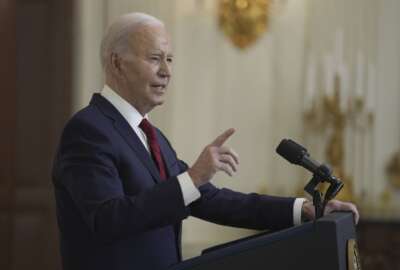Hubbard Radio Washington DC, LLC. All rights reserved. This website is not intended for users located within the European Economic Area.
FERS for dummies
The new Federal Employees Retirement System is suddenly not so new. It turned 25 this year. And next to Social Security, it is the dominant federal retirement p...
Twenty-five years ago, Uncle Sam, the U.S. Senate and the Congressional Research Service labored, fought, horse-traded and eventually brought forth the Federal Employees Retirement System — FERS, as it is known to friend and foe alike.
It was a new retirement plan designed to replace the Civil Service Retirement System. It was modeled after the most progressive private-sector plans with a defined government benefit, Social Security and a super-401(k) plan into which the employer would match up to 5 percent of an employee’s contributions to the Thrift Savings Plan.
The late Sen. Ted Stevens (R-Alaska), who was a major backer of the federal workforce (Alaska has a high percentage of government employees), was the driving force behind the idea of FERS and getting it through Congress. The Congressional Research Service provided much of the technical help and information that formed FERS. Stevens’ top assistant, Jamie Cowan, who is now in Israel, walked it through the political and legislative process.
Like all babies, FERS was tiny. For a while. When it was launched, workers under the CSRS program were allowed to either stick with it or switch over to the new plan. Only 2 percent did. Years later, during the Clinton administration, another open season was held (the White House opposed it but Congress insisted). At that time, another 2 percent switched from CSRS to FERS. Most were women who wanted to be able to qualify for Social Security benefits.
CSRS is thought to be a better plan for lifers. That is, people who make a full career in government. It promised them a generous, indexed-to-inflation retirement stream. The problem is that less than one-third of the people who come into government stay long enough to retire.
But for people who don’t work in government until retirement, FERS — with its Social Security coverage and generous TSP component — is the better deal.
While most current federal and postal retirees are under the old CSRS program, the majority of working feds — maybe 8 out of 10 — are under FERS.
FERS was set up to replace the CSRS system because politicians, even way back when, realized that the cost of the CSRS program to the government and taxpayers would make it a political and budgetary target.
A former union leader, who fought against the introduction of FERS, said he came to realize that it had to happen. “Having such a generous defined federal benefit program with an employee contribution equal to Social Security would have been politically unsustainable,” he said. “FERS, or something like it, had to happen.”
John Elliott, a long-time federal benefits specialist and an expert on the CSRS and FERS programs, said it is a success in several ways, including in making feds stakeholders. He said:
I think we can say FERS has been a success, particularly if we contrast the federal retirement plan with state and local retirement plans that, in too many cases, are threatening to bankrupt their governmental jurisdictions. FERS is a pay-as-you-go plan that is not threatening the American taxpayer, even though irresponsible politicians propose cuts that would undermine FERS and ultimately the federal workforce. FERS retained a defined-benefit plan, the FERS annuity, although it is far less generous than the venerable CSRS. After 1983, new federal employees and the Congress became covered by Social Security, joining the rest of America as stakeholders in the system. Finally, FERS introduced a defined-contribution plan, the TSP, that further linked the federal community with the rest of America and their 401(k)s. So, I think the biggest contribution FERS has made is that federal employees and the Congress look a little bit more like the rest of America, at least in terms of their retirement plan. FERS was part of the solution, not part of the problem that many state and local retirement plans are proving to be.
Today on our Your Turn radio show (at 10 a.m. EST), we will talk with two people who were present at, and even before, the creation of FERS. They are Judy Park and Tom Trabucco.
Judy is the retired legislative director of the National Active and Retired Federal Employees (NARFE) Association. Tom recently retired as director of external affairs for the Federal Retirement Thrift Investment Board. Both worked for unions (the AFGE and NFFE) and had a hand in crafting the FERS program.
Listen if you can (1500 AM or online), and if you have questions email them to me at mcausey@federalnewsradio.com or call in during the show at (202) 465-3080. The show will be archived here.
To reach me, mcausey@federalnewsradio.com
NEARLY USELESS FACTOID
By Jack Moore
The “I Can Be a Doctor Barbie,” which sells for $32.91 on Amazon.com costs more than twice as much as the “I Can Be a Magician Barbie.”
(Source: Slate)
MORE FROM FEDERAL NEWS RADIO
Nominate a top leader in federal service
Got a boss or work with someone who’s an effective leader? Federal News Radio wants to know, who are the best leaders in federal service? Who has inspired you and what qualities do you think make a Top Leader? Nominate someone today! Finalists will be chosen by a panel of judges and featured in a special report on leadership in February.
Supreme Court rules feds
The Supreme Court ruled Monday that federal employees can appeal discrimination-related complaints in federal district court. The ruling follows earlier lower court decisions that forced employees to appeal some Merit Systems Protection Board decisions through the U.S. Court of Appeals for the Federal Circuit.
Survey: Limits on MSPB resources affect employee productivity
A closer look at the results of the Merit Systems Protection Board’s 2012 Federal Employee Viewpoint Survey (FEVS) reveals that the limits of the agency’s resources are having a negative effect on its employees and their ability to do their jobs. In 2012, the MSPB averaged a positive level of 64.6 percent in the 71 core questions of the survey. This is a significant drop from the two previous surveys in which the agency received results of 69.1 percent (2011) and 70.4 percent (2010).
Agencies turn to social media to engage public in an emergency
In an emergency, would you call someone or text them? Maybe you would just tweet or post to Facebook to get the word out to a lot of people quickly. “Social media offers that unique ability in order to engage and listen in real time to the needs of citizens,” said Justin Herman, the social media lead for the Office of Citizen Services and Innovative Technologies at the General Services Administration.
More from FERS: 25 Years Later
Couple navigates FERS-CSRS retirement divide
Your Turn – FERS: 25 Years Later
Fight for federal retirement overhaul offers lessons for today’s fiscal challenges
TSP Tracker: Annual returns from 1987 – today
Copyright © 2024 Federal News Network. All rights reserved. This website is not intended for users located within the European Economic Area.
Mike Causey
Mike Causey is senior correspondent for Federal News Network and writes his daily Federal Report column on federal employees’ pay, benefits and retirement.
Follow @mcauseyWFED
Related Topics





